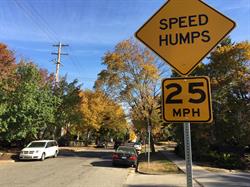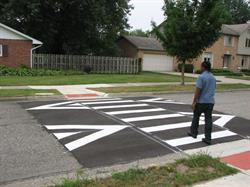What can I do to slow vehicle speeds in my neighborhood?
Introduction

If you are looking for a way to make cars drive slower on your neighborhood street, the City of Ann Arbor Traffic Calming Program may be a good fit. Traffic Calming slows traffic through physical changes (such as speed humps and curb bump-outs) that impact the behavior of people driving cars and improve conditions for people living, walking, and bicycling in local neighborhoods.
This program is a formal process for residents and property owners to engage the city in a partnership to explore traffic concerns, and potential solutions, on local streets.
 For more information, please review the
Traffic Calming Guidebook or check out the
Program FAQ.
For more information, please review the
Traffic Calming Guidebook or check out the
Program FAQ.
To see examples of traffic calming around Ann Arbor and locate specific project materials, visit the
Projects page.
Disclaimer
Resolution R-23-330 directs staff to update the Traffic Calming Program. Our dedicated team is diligently working on these updates, which will impact the current petition process as outlined in the guidebook. However, the city wants to emphasize that residents should not be discouraged from submitting a petition. Applications will be placed in queue, and upon update, petitioners will be notified of additional information required for a qualifying petition.
Request Traffic Calming
Please review the
Traffic Calming Guidebook or contact
[email protected] or 734.794.6429 for more information on the petition process and program qualifications. It is recommended that you leave a voicemail when calling 734.794.6429 so that staff know they missed you and can return your call.
Process Overview Diagram (Subject to change)
Process is as follows:
1) Resident initiated Petition: Define project limits and establish community buy-in early.
2) Initial Questionnaire: Collect feedback about existing conditions.
3) Meeting #1 orientation/workshop: Advance understanding of program and options while gathering additional feedback.
4) Meeting #2 onsite/workshop: Visualize draft plan on-site.
5) Final polling: determine project area response to proposed plan.
Petitions are considered on a first-come first-served basis. The Traffic Calming Process may take more than one year from petition submittal to construction, visit the
Projects page.
Resources
Traffic Calming Guidebook
Traffic Calming Petition and Request Forms (Updated September 2020)
Property Manager Petition Form
Petition Evaluation Categories
Updated Program (09/05/2023) Legislative Information
Updated Program (11/19/2018) Legislative Information
Institute of Traffic Engineers (ITE) Resources
New Sidewalk FAQ
